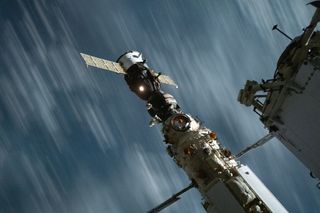
Unplanned thruster firings by a Russian spacecraft briefly knocked the International Space Station off-kilter today (Oct. 15), the second such incident in less than three months.
The spacecraft involved today was the Soyuz MS-18, which is scheduled to bring cosmonaut Oleg Novitskiy, film director Klim Shipenko and actor Yulia Peresild back to Earth early Sunday morning (Oct. 17). Russian flight controllers fired up the vehicle's thrusters at 5:02 a.m. EDT (0902 GMT) in a planned pre-departure test.
"The thruster firing unexpectedly continued after the end of the test window, resulting in a loss of attitude control for the International Space Station at 5:13 a.m.," NASA officials wrote in an update this afternoon.
"Within 30 minutes, flight controllers regained attitude control of the space station, which is now in a stable configuration," they added. "The crew was awake at the time of the event and was not in any danger."
Related: International Space Station at 20: A photo tour
The orbiting lab briefly tilted from its normal orientation this morning by 57 degrees, according to the Russian news agency Interfax, which cited communications between Novitskiy and Vladimir Solovyov, the flight director of the station's Russian segment.
Space station managers don't yet know what caused the anomalously long firing. NASA and Russia's federal space agency, known as Roscosmos, are looking into that together at the moment, NASA officials wrote in the update.
Get the Space.com Newsletter
Breaking space news, the latest updates on rocket launches, skywatching events and more!
It's also unclear why the MS-18's thrusters stopped firing, though the station's handlers have some ideas.
"We think — and we haven't got confirmation — we think the thrusters stopped firing because they reached their prop[ellant] limit," NASA flight director Timothy Creamer told agency astronauts shortly after the thrusters shut down, according to The New York Times. "Moscow is checking into it and doing their data analysis."
The space station was also accidentally spun on July 29, when the thrusters of Russian's newly arrived Nauka module did some unplanned firing. That incident was even more extreme, rotating the orbiting lab by about 540 degrees.
Russian officials traced the July 29 event to a software glitch.
"Due to a short-term software failure, a direct command was mistakenly implemented to turn on the module's engines for withdrawal, which led to some modification of the orientation of the complex as a whole," Roscosmos officials wrote in a statement published on July 30.
Despite today's drama, the Soyuz MS-18 remains on track to return to Earth this weekend. The spacecraft will undock from the station on Saturday (Oct. 16) around 9:14 p.m. EDT (0114 GMT on Oct. 17) and will touch down on the steppes of Kazakhstan about 3.5 hours later. You can watch all the action here at Space.com, courtesy of NASA TV.
Novitskiy spent about six months in orbit, but Shipenko and Peresild are coming home after just 12 days. The duo launched on Oct. 5 to film part of a Russian movie called "Challenge" on the space station. They lifted off with cosmonaut Anton Shkaplerov, who remains on the orbiting lab.
Mike Wall is the author of "Out There" (Grand Central Publishing, 2018; illustrated by Karl Tate), a book about the search for alien life. Follow him on Twitter @michaeldwall. Follow us on Twitter @Spacedotcom or Facebook.
Join our Space Forums to keep talking space on the latest missions, night sky and more! And if you have a news tip, correction or comment, let us know at: community@space.com.

Michael Wall is a Senior Space Writer with Space.com and joined the team in 2010. He primarily covers exoplanets, spaceflight and military space, but has been known to dabble in the space art beat. His book about the search for alien life, "Out There," was published on Nov. 13, 2018. Before becoming a science writer, Michael worked as a herpetologist and wildlife biologist. He has a Ph.D. in evolutionary biology from the University of Sydney, Australia, a bachelor's degree from the University of Arizona, and a graduate certificate in science writing from the University of California, Santa Cruz. To find out what his latest project is, you can follow Michael on Twitter.
